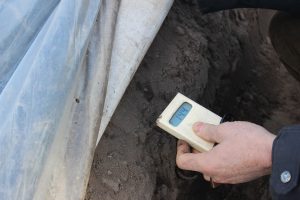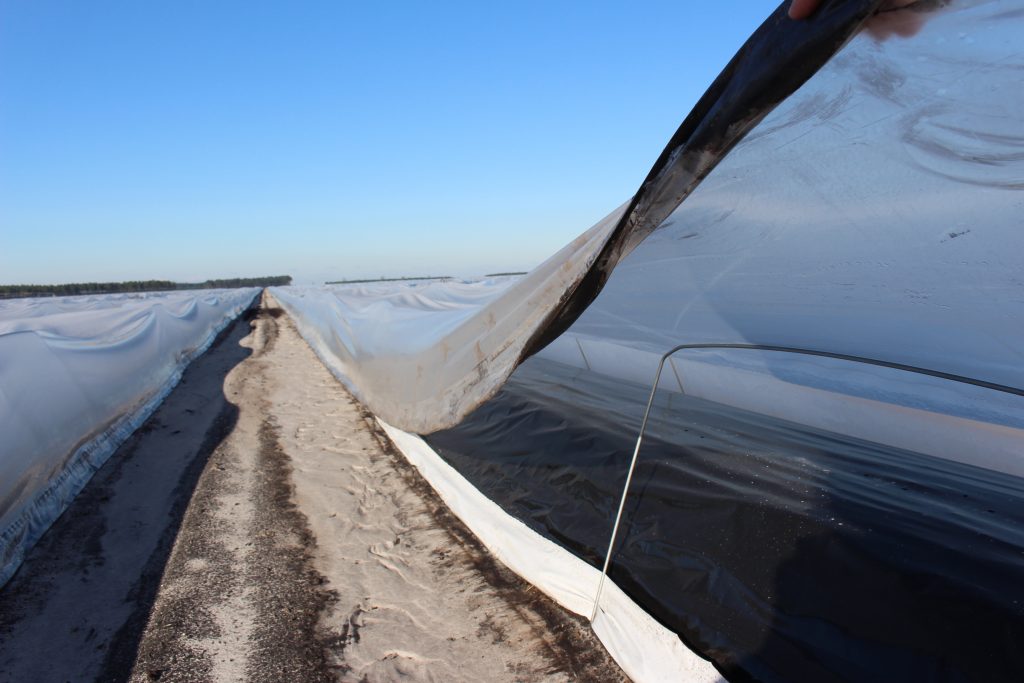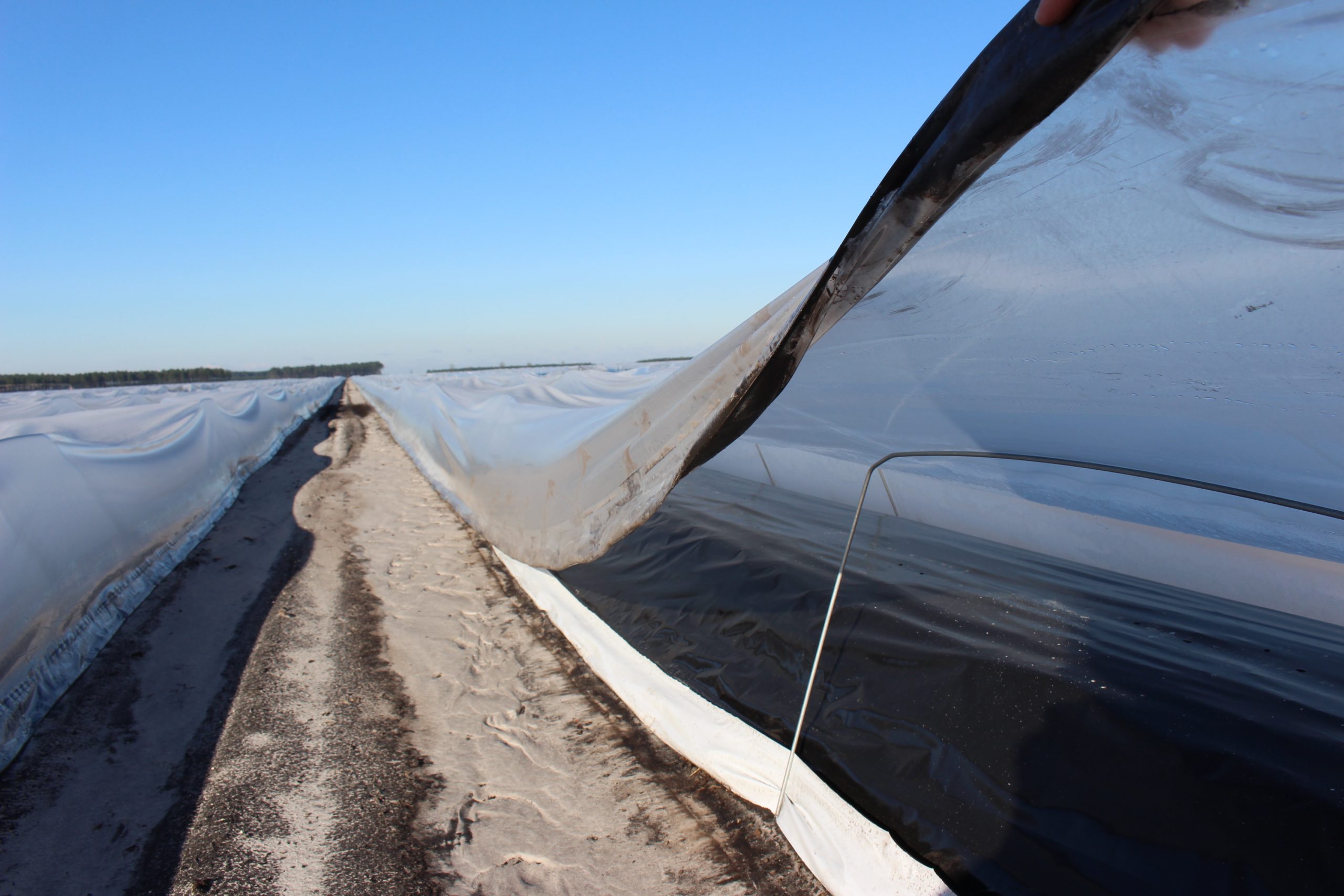Plastic films boost asparagus
The use of plastic cover films has brought asparagus cultivation into a new area. In the 1980s, a few microns of clear thermal plastic first warmed the soil more quickly to gain precocity, and then the widespread use of black/white pocket plastics in the 2000s profoundly changed production techniques. Today, the use of arches and the combining of plastics mean that production can be managed according to the meteorology, the production slots targeted, the availability of labour and market prices.
A “temperature comfort range”
But plastic films are first and foremost used as a way to improve the yields of an asparagus crop. According to data compiled by Christian Befve, an asparagus consultant, each plastic and plastic combination brings a gain in production. They all allow yields to be doubled (see GRAPH 1). Plastic films act first on the temperature of the soil. The rise in temperature depends on the ambient temperature but especially on the sunlight and the intensity of the light that passes through the thermal mulch. Temperature is a decisive factor in the growth of asparagus. Physiological data indicate that asparagus wakes up when the temperature reaches 11 degrees at 10 cm below the root plateau for early varieties (Darlise, Vitalim etc), 12 degrees for mid-season varieties and 13 degrees for late varieties. Temperature also has a direct influence on productivity. At the beginning of the season a degree Celsius gained starting from when the plant wakes means an extra 30 kg/ha/day harvested, in mid-season it is 10 kg/ha/day. On the other hand, if the temperature exceeds 25 degrees C at 10 cm below the plateau, the yield can drop in the order of 10%. At above 350C, production activity is almost nil.
The temperature in the mound is very important for the growth of asparagus, for the quantity harvested and the quality of the spears. According to established data, the asparagus must be in a “temperature comfort range” of between 18 to 20 degrees Celsius at 20 cm below the top of the mound. Below this, the asparagus grows little. Above, spear quality problems appear (pinking, flowering). The data provided by Engels Machines show that it is possible to regulate the temperature of the mound by managing the different plastics and their positioning. The management of plastics is conducted according to the temperature of the mound. This management is subject to different influences and depends on a variety of objectives: desire for precocity, reduction of production peaks, spread of production, regularity of quality, etc. and better management of the workforce.
Playing with different configurations of films
The increase in temperature in the mound is related to the radiant heat reaching the mound. This can be modulated in different ways. Engels Machines has defined 6 installation combinations of three mulch films that can influence the temperature increase in the mound. Taking 100 as a base for the mini-tunnel+black plastic configuration, graph 2 shows a decreasing gradient of the thermal effect of different combinations. It can be noted that in all cases the white face reduces the thermal effect of the sun exposure the most. But it cannot be said that it cools the mound. This management of the various plastic covers can be carried out during the harvest with assistance machines with no additional working time. Regulation of the mound temperature requires forward planning by observing the temperature in the mound and taking into account the future climatic parameters (temperature, sunshine, rain, etc.). So Engels Machines has defined the management criteria and offers a plastics management service. It shows that it is possible to moderate the temperature of the mound in the plant’s comfort zone, 18 to 22 degrees Celsius, by adjusting the different configurations of the films (see Graph 3). According to Tom Smolders of Engels Machines, who worked on establishing this data, a more stable temperature over 24 hours reduces the percentage of hollow stems. This qualitative problem occurs when the temperature difference between the top of the mound and the root plateau is greater than 4oC. The different plastic films are not only for gaining in precocity. On a late variety (eg Backlim) it is also possible to use a combination of high-performance film to group production and limit the harvest period in order to lengthen the growing period of the plant.
“Compromise solutions” between precocity and use
Given the strategic importance of plastic films, manufacturers have expanded their range with increasingly specific and technical films. The thickness of the films is increasing the main reason for which is the direction of laying on the arch. According to Daios, the film placed perpendicularly requires a thickness of 50 microns to ensure their maintenance. On the other hand, a film placed parallel to the arch must be of greater thickness of 70 microns. With the development of harvesting machines, this mini-tunnel technique is being widely developed because it allows the use of two plastic layers without increasing the time devoted to the laying and lifting of films. While the covering and uncovering of films placed perpendicular to the arches increase harvest time by 30%. The race for the precocity brought about by the use of plastic films comes at a cost. It is quantified by adding the costs of plastic films, the depreciation of the arches and harvesting machines, the cost of refilling pocket films (estimated at 0.12 euros in France), laying and lifting, storage, etc. and the cost of recycling, which will only increase.
In response to this, some manufacturers offer “compromise solutions” between precocity and ease of use by welding together a black/white pocket plastic film and a thermal plastic one. This double film creates an air space between the black/white film and the thermal film that acts like a mattress and allows the mound to heat up. This double film can be placed on arches with a new insulating effect between the film and the mound. This area permits the condensation of moisture from the area to re-humidify the mound. According to Europlastic, the manufacturer of this film, the thermal film is enriched with UV stabilisers in order to increase its lifespan and make it equivalent to the black/white cover. The two films used together also have better resistance to handling that extends the life of the cover. Additionally, at the time of set up it requires one single filling of the pockets. It also means less rolls in storage post-harvest. So Europlastic is talking about an economical film.
GRApH 1 PLASTIQUE source C.befve
In its range of mulch films, Reyenvas offers a 7-layer film using technology to incorporate a thermal layer inside the black-white film. Combining these properties gains 3 to 5 days of precocity compared to a conventional black/white film. This unique film limits the cost of refilling pockets, handling, and then storing. The 7-layer film is thicker (175 microns) and more resistant. There is a tendency evolving towards thicker films that will also be more resistant. Their lifespan will be extended to provide a partial solution to the plastic recycling problem. The lengthening of the film life, also offered by Daios, increases the years of film depreciation and reduces the cost of recovery taxes and disposal difficulties.
GRAPH 2 6 configuration Percentage
It is becoming desirable for plastics to be more discreet. For this reason, manufacturers such as Daios and Reyenvas offer green/white films to better integrate into the landscape. According to Daios, these films would also provide temperature gains compared to black/white film.
GRAPH 3 Effect foil management
More Info
Controlling with plastics
Early production: planting an early variety at shallow depths with several plastics and mini-tunnels
Late production: plant a late variety at depth and cover with white plastic
Grouped production: regulate the temperature of the soil at the root plateau (between 18 and 21 degrees Celsius) depending on the variety by managing the different plastic films
Spread-out production: plant several varieties at different depths and use several combinations of plastic films

Anticipating to limit temperature
Black mulch heats up more than white. White mulch limits the temperature in the mound despite a slight increase in temperature. It doesn’t cool the mound. It is therefore necessary to anticipate the changeover of face well before temperatures in the ground become too high. To regulate the temperature of the mound moderately, after the black plastic + tunnel it is better to use the white face and keep the other plastic on the tunnel, rather than take the plastic off of the tunnel and keep only the black. This second technique causes too great a temperature range in the mound.
Plastic and quality
The quality of the asparagus is made in the mound and on the mound. The use of plastics plays a big role in the quality of crops.
In the mound: It is important to limit the temperature range, between 18 and 21 degrees Celsius depending on the variety, to prevent the asparagus tip from flowering and to keep its tip closed.
On the mound: the temperature on the surface of the mound, and under the plastic, can get very high (60oC) causing the tip to burn. To reduce the losses due to this problem, harvesting must be done early in the morning, the plastic blanket must be turned white face on the outside. It is possible to place hoops very close to the mound that create an air cushion between the mound and the black/white plastic.























